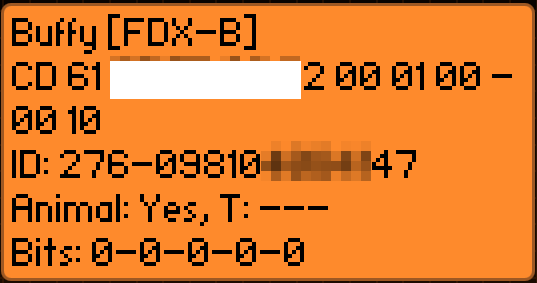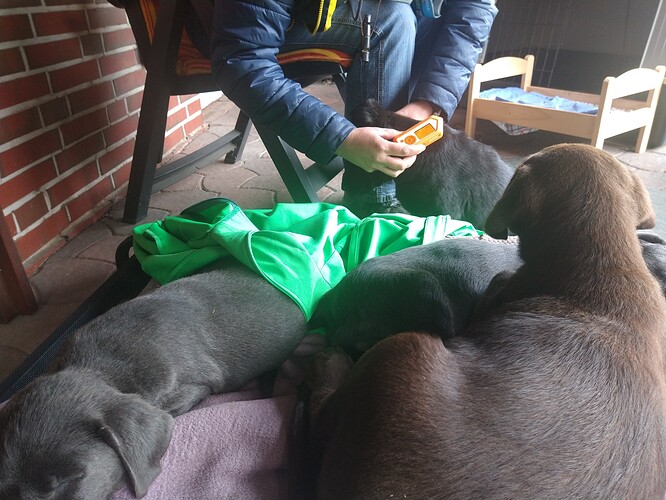Yes, all animal tags are 134.2khz and are being read fine by the flipper
Yesterday I’ve tried to scan the tag from our dog. She got a lot of treads, but after 40 minutes of experimenting I gave up.
I talked to this my wife about this. This morning, she took the flipper, put the dog down (nicely) and after less than 5 seconds the flipper was happy. Even with the orange bumper case.
To be fair, she used to worked at a animal shelter and read a lot tags with different kind of readers before and even knows how they are inserted.
I am convinced this was not a technical issue, here.
My wife explained to me, with most readers she don’t even need to touch the dog/cat/fish/pigeon/cow/animal (yes, fishes get RFID tags, too. This was new for me). But here I am the expert again, so the antenna of a dedicated reader is much bigger as in the flipper. But you don’t need to ‘press it into the animal’, the key is holding very still over the place of the tag. I’ve seen it 
(yes, fishes get RFID tags, too. This was new for me)
If you connect your large fish to an ethernet network do you get a Wireshark?
During my research I’ve found this site: » RFID devices for Conformance certification: Injectable transponders (Pets) | ICAR
A interesting list of available transponders.
I know the code is 15 digits long. And there is a 3 digit county code.
From this list I assume
- the first three digits are the manufacture code
- the following three are the product code
- from digit 7 to 15 is a counting number?
From the list we can also read FDX-B and HDX. The difference between FDX-B and HDX is explained here: ISO 11784 and ISO 11785 - Wikipedia
There is a [newer standard](ISO 14223 - Wikipedia], but the site is not nearly as helpful as the older standard.

Here I am giving a little personal information. My dogs name is Buffy. But this is not from the Implant, that is the filename. The data are transmitted in FDX-B (Full Duplex, see above).
We see the three digit country code at the start of the code. Translation: ISO 3166-1 numeric - Wikipedia (Yes, personal again. Buffy is from Germany. I am allowed to share his information, I asked her, gave her a tread and she agreed happily).
And than a bunch of numbers. The chip is from 2010, the icar.com says a registration is valid for 5 Years. I assume this is the reason, why I can’t find a match. between the database and the number.
xxxyyyzzzzzzzzz
If I am correct, and the first 6 digits are reserved, this means we have 999.999.999 possible numbers available?
7.600.000.000 People on earth, can have 7 pets each, if all would be tagged with one type from one manufacturer. And I thought the number is too small. Just don’t start to tag your fishes at home!
Maybe you could ask your wife to share some tips and tricks on how to scan the tag correctly? 
My wife said it is easy, you just need to know where the tag is (Now I know how she felt, if I tell her how easy it is to replace RAM).
It is at the neck on the left side… Nothing I don’t know before. At least, because it is written in the Dogs Passport.
Today Buffy doesn’t feel well, I let her sleep. But I’ll try again and try to capture a video or photo of the process. Maybe this will help others.
Edit: Buffy went for food, so I’ve tried again … Nothing. My wife did it → not 10 seconds, hit.
My observations:
- There is much more yellow blinking, than I expected. I don’t know because of the organic electricity or the fur (static electricity).
- I’ve searched way to low. The tag is nearly a hand wide down rear from the left ear (Buffy is a Irish Setter Labrador, so let’s say middle sized or knee high).
Ok, I finally managed to scan the tag once. After the line about “yellow blinking”, I used that as location clue like “Hot and Cold”. Tag must be super close to flipper and it’s not an easy task when it’s located between the shoulder blades.
I asked my personal consultant about the place ‘between the shoulder’ and she agreed. It is possible, because the implants can move under the skin.
But there is no way to tell what way it will move or how fast. In a perfect world it shouldn’t.
But animal hunter get devices with bigger antennas to ‘scan’ a bigger area. As said before, these are dedicated for one task, not for many, as our flipper.
Yes, the yellow light is a good start. Better lay your pet on a ESD mat, to avoid static loading  … Or just move the flipper very slow, after a yellow blinking over the same spot.
… Or just move the flipper very slow, after a yellow blinking over the same spot.
PS: I haven’t got a positive result by myself until today. I’ll keep trying.
Today I was able to ‘play’ with two more dogs.
Yuma was a good girl and let me scan the Tag. Yay!
Jamie also stand very brave, but not possible to scan her tag. Also for my wife.
But ‘Read RAW’ got a result. Now I am ask myself, if it is related to the FDX vs. HDX.
Has anyone got a success with a HDX tag?
I got the permission to save the Dump, but not to publish/share it from the owner of Yuma and Jamie.
So I got a RAW dump from both dogs and try to find out more.
One of my cats had his chip grow out of him. So I had to get him a new chip (and passport). Reading the old chip worked fine. I however haven’t managed to read the chips inside my cats yet. Guess it’s just harder to get the signal through the skin.
First of all, thank you for sharing  The yellow blinking tip is very helpfull to locate the chip and read it. I have 3 cats, and I managed to read 2 of them (the third one was not very cooperative ^^).
The yellow blinking tip is very helpfull to locate the chip and read it. I have 3 cats, and I managed to read 2 of them (the third one was not very cooperative ^^).
I found a french article about the code on ID chips (Comprendre la codification d’une puce d’identification | Kitkat & Co ) :
- FDX-B is indeed ISO11784/11785 and use indeed a 15 digits code :
→ the first 3 digits are a country code
→ the next 2 digits are a species code
→ the next 2 digits are a manufacturer code (delivered in France by the Ministry of Agriculture)
→ the last 8 digits are a unique ID code - FCX-A is a 10 digits code, used before 1996 in Europe and still in use in some countries (the article mentions North America and Mexico)
Note the some countries do not follow the ISO standard and have their own codification (GB for example).
In Europe, you can check pet ID on europetnet.com.
I have still a technical question : flipper only saves the hexa A code, not the decimal pet ID. I assume the decimal ID is just a conversion of the hexa code, but I didnt manage to recover the decimal ID code from the hexa code (I tried hexa to ascii with the most common character encoding tables, and direct hexa to decimal conversion).
If someone has an idea… 
Hi,
thanks for tip with the LED. This helped to find the transponder on my “Garfield”. Before knowing this I could read only my other cat who is very thin.
A good place to check the Pet ID´s on seem to be petmaxx.com. They claim to search international, found the tagnumber of my cats an re-directed correcly to Tasso where I made the registeration.
The Flipper worked very well with the sheep eartags. It turned out only from each pair of tags has a transponder. Mine are official registered but cannot be found on any of the pets transponder search platforms. Most probably the german livestock databases are not open to public.
Goat and cattle should use the same tags.
Yes, there is a difference between house pets (injected) and let’s say ‘industry animals’ (ear tag). I don’t know if cattle is only one specific group of animals. But I can imagine there is also a difference in registration between sheep, cow, pigeon, pig, …
Here is a useful information, but unfortunately only on German: Transpondercodes - Tierärztekammer Hamburg
Summary:
[…]
Europetnet: www.europetnet.com/
PETMAXX: www.petmaxx.com/
Denmark, Spain, Polland are only using Europet.
In Germany Petmaxx is used by all tree registers (DTB, Tasso, Ifta) and Tasso also registering at Petmaxx.
[…]
A few weeks ago we’ve “found” a disoriented dog on the street. She got a Tasso Tag (I haven’t have a flipper, back then). We called Tasso and they rolled us this is Betty. We gave them our position and the allowance to forward our contacts.
They tried roundabout an hour to contact the owner, but never release any information about them. The owner was not in reach, of course, because she was searching for her dog… Bit after a while Tasso managed a contact and informed us she is on her way.
This was a interesting day in focus of data protection and a fast way to get in touch…
Personal footnote: Please make sure your telephone number (best mobile) is valid at Tasso.
Today I’ve got 4 more Dogs, that where be tagged 6 Days ago.
Of course my wife got all tags, instant. For one Dog I need to turn the Flipper 180°. I’ve tried 3 minutes in normal left handed position, my hand got cold → turn around, works.
A little awwwpload: My wife is scanning Dog 4.
It works, but you have to find the exact spot (antennas from vets scanner devices are much bigger and therefore easier to get a read)
Look at the yellow LED and if you see it, search closer in that area. That’s what ultimately helped me find the chip.
Good Luck
Tried with my Siberian Husky but no way, fur is too dense I guess 
Sometimes the Chip is moving. Unfortunately nobody can say in which direction.
For older dogs it always helped me to start with ‘Read ASK’ from the left shoulder, near the neck and go back until the LED goes yellow. For long fur it goes more often yellow, but after scanning twice, you’ll get a feeling for false positive.
Right now (with a lot help from my wife) I was able to scan every dog.
And a friend of mine, in the Tattoo and Beauty business was so interested in Flipper and now got registered for human NFC/RFID implants… Soon I can start scan myself 
Additional, how Avid (Manufactor of Animal Tags) recommend to move the scanner:

Source: https://www.avidid.com/sites/default/files/product_manuals/AVID1034-3_MT3_Manual.pdf - Page 3 (with more explanation, I won’t copy here, because of copyright)
The issue with that is that Flipper can’t read tags while in motion, the antenna doesn’t have enough time to settle. You have to keep it completely still for 2-3s, then move it a bit, and then keep it still again
Good point. Haven’t thought of this limitation.

